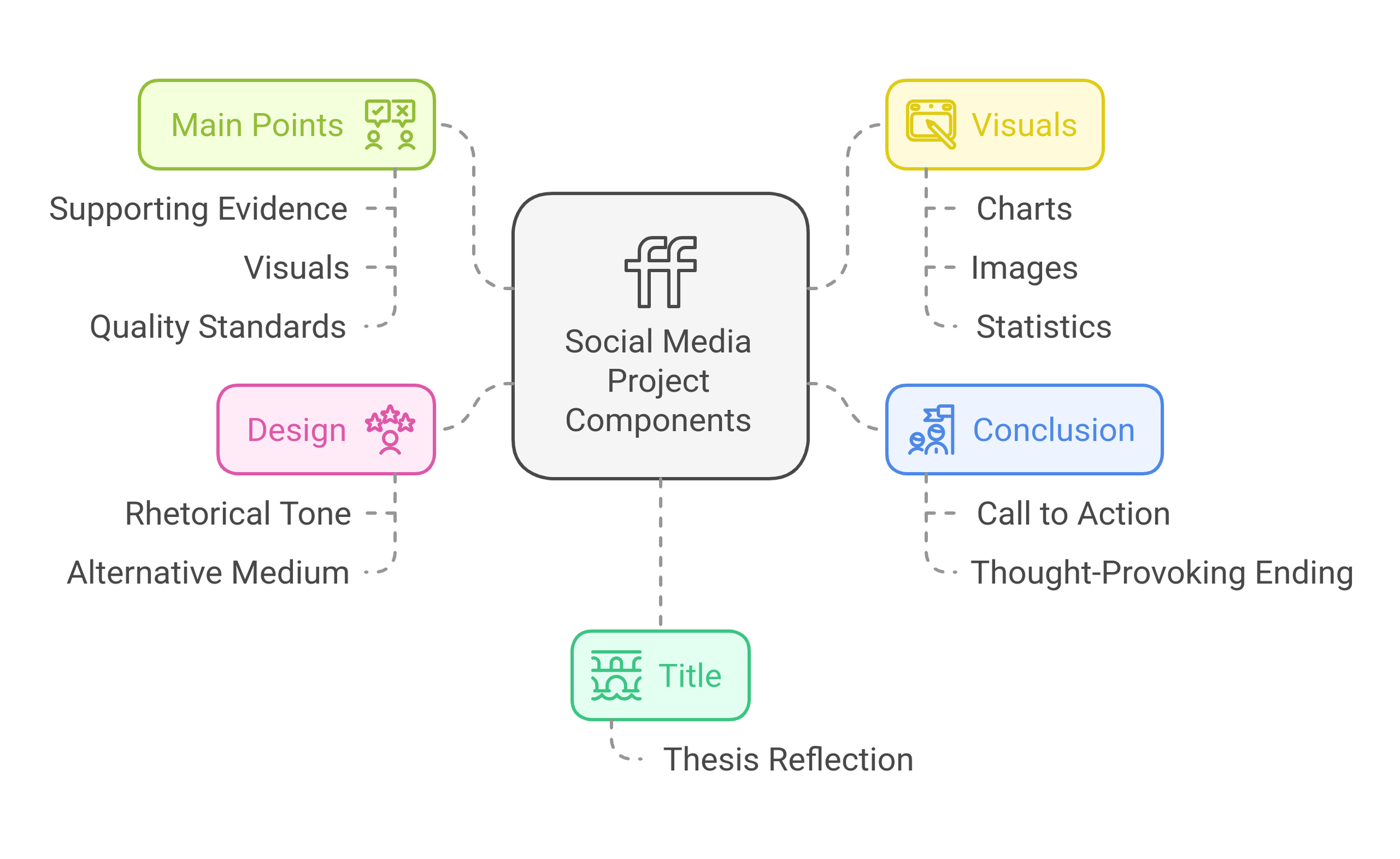Final Project: The Impact of Social Media – Argument and Creation
Objective:
You will craft an argumentative essay analyzing the impact of social media on society, synthesizing ideas from "The Digital Paradox: How Social Media Reshapes Our World and Ourselves" and "The Digital Renaissance: How Social Media Revolutionizes Human Connection and Progress." You will also create a Canva infographic or digital poster (or an alternative creative project) that visually represents the key ideas from your essay and analyzes the rhetorical strategies employed in the provided articles.
Project Components
Argumentative Essay (60% of grade)
Prompt:
Does social media ultimately harm or benefit society? Develop an argument synthesizing evidence from “The Digital Paradox: How Social Media Reshapes Our World and Ourselves” and '“The Digital Renaissance: How Social Media Revolutionizes Human Connection and Progress.” Analyze at least one rhetorical strategy each author uses to advance their argument.
Requirements:
Write a clear, defensible thesis.
Incorporate at least two direct references (one from each article). Analyze how these references are used rhetorically to support the author's claims.
Address counterarguments.
Identify and analyze at least one specific rhetorical strategy used by each author (e.g., ethos, pathos, logos, tone, diction, syntax).
Minimum length: 750-1000 words.
Creative Component (40% of grade)
Objective:
Create an infographic or digital poster using Canva (or an alternative medium such a short video, or a podcast) that visually represents your essay's key argument or theme and highlights the rhetorical strategies analyzed.
Requirements:
Include:
A title that reflects your essay’s thesis.
At least three main points with supporting evidence or visuals (e.g., charts, images, or statistics) that relate to your essay's argument.
A call to action or thought-provoking conclusion.
Visual representations or annotations that showcase the rhetorical strategies you analyzed in your essay. For example, you might highlight a particularly effective use of pathos in a quote with a specific color or icon.
Ensure a professional, visually appealing design that connects to the rhetorical tone of your essay.
If choosing an alternative medium, ensure it meets the same content and quality standards as the Canva option. Consult with the teacher for approval on your chosen alternative.
Timeline and Daily Breakdown
Day 1: You will introduce the project and distribute the articles (The Digital Paradox and The Digital Renaissance). You will read and annotate key arguments, identify rhetorical strategies, and note potential visual representations for your creative projects. For homework, you will write a thesis statement and outline the rhetorical strategies you plan to analyze. Be sure to bring in copies or links to the articles.
Day 2: Review thesis statements and rhetorical analysis outlines in class. Draft the essay body paragraphs (focus on synthesis, evidence, and rhetorical analysis).
Day 3: Peer review essays in class ( focusing on argumentation, evidence, and rhetorical analysis). Begin revising drafts. Homework: Complete essay revisions.
Day 4: Submit essays for teacher review. Begin designing the Canva infographic/poster (or planning the alternative creative project). Explore Canva templates and plan the design, incorporating elements highlighting the rhetorical analysis. Students choosing alternative media should begin working on their projects and seek teacher feedback.
Day 5: Create the Canva infographic/poster (or alternative project) in class. Finalize designs as homework.
Day 6: Present Canva projects (or alternative projects) in small groups for peer feedback. Students will explain their argument, design choices, and how they represented the rhetorical analysis. Polish designs. Provide a rubric for the presentation element.
Day 7: Submit final essays and Canva projects (or alternative projects). Host a gallery walk to showcase the Canva designs (or alternative projects).
Grading Rubric
Essay (60% total)
Thesis (10 points): Clear, defensible, and nuanced.
Evidence (10 points): Use at least two article references effectively.
Argument Development (10 points): Logical reasoning, counterarguments, and organization.
Rhetorical Analysis (10 points): Accurate and insightful identification and analysis of at least one rhetorical strategy from each article.
Writing Style (10 points): Grammar, syntax, and rhetorical tone.
Canva Infographic/Poster (or Alternative) (40% total)
Design Quality (10 points): Professional and visually engaging (or appropriate quality for the chosen medium).
Content Accuracy (10 points): Clearly conveys the essay’s key argument and evidence.
Creativity (10 points): Thoughtful use of visuals, layout, and call to action (or equivalent creative elements in the chosen medium).
Connection to Essay and Rhetorical Analysis (10 points): Alignment with essay thesis, tone, and clear visual representation of the analyzed rhetorical strategies.







